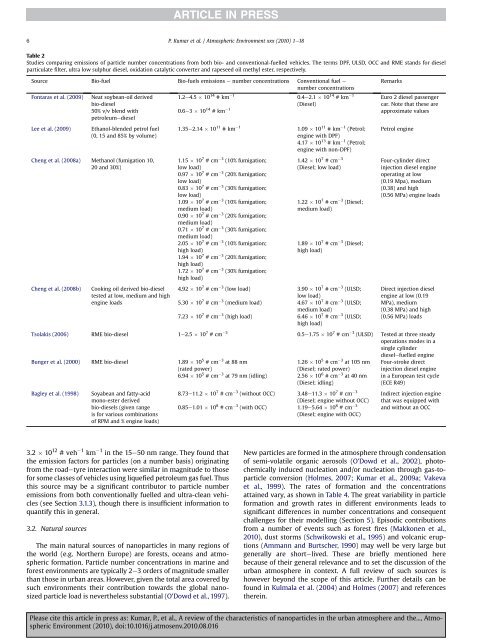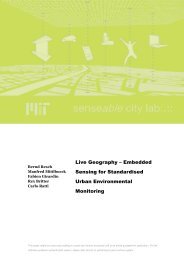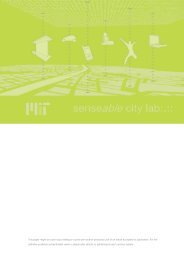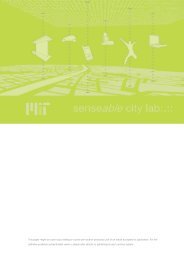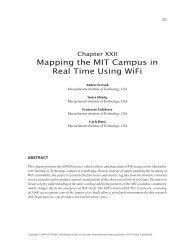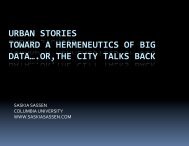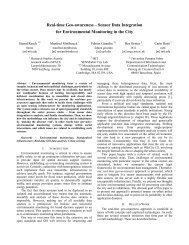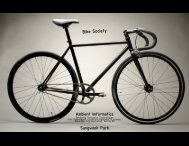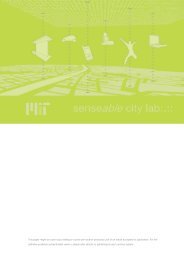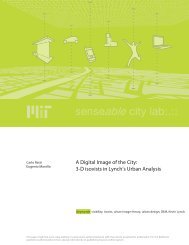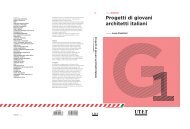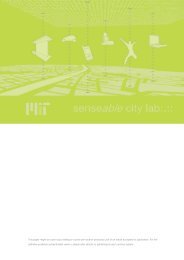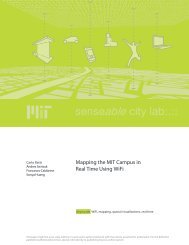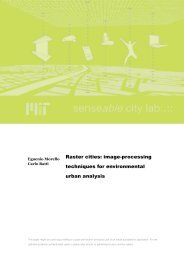A review of the characteristics of nanoparticles in the urban ...
A review of the characteristics of nanoparticles in the urban ...
A review of the characteristics of nanoparticles in the urban ...
Create successful ePaper yourself
Turn your PDF publications into a flip-book with our unique Google optimized e-Paper software.
6<br />
P. Kumar et al. / Atmospheric Environment xxx (2010) 1e18<br />
Table 2<br />
Studies compar<strong>in</strong>g emissions <strong>of</strong> particle number concentrations from both bio- and conventional-fuelled vehicles. The terms DPF, ULSD, OCC and RME stands for diesel<br />
particulate filter, ultra low sulphur diesel, oxidation catalytic converter and rapeseed oil methyl ester, respectively.<br />
Source Bio-fuel Bio-fuels emissions e number concentrations Conventional fuel e<br />
number concentrations<br />
Fontaras et al. (2009)<br />
Lee et al. (2009)<br />
Neat soybean-oil derived<br />
bio-diesel<br />
50% v/v blend with<br />
petroleumediesel<br />
Ethanol-blended petrol fuel<br />
(0, 15 and 85% by volume)<br />
Cheng et al. (2008a) Methanol (fumigation 10,<br />
20 and 30%)<br />
1.2e4.5 10 14 #km 1 0.4e2.1 10 14 #km 1<br />
0.6e3 10 14 #km 1<br />
1.35e2.14 10 11 #km 1<br />
1.15 10 7 #cm 3 (10% fumigation;<br />
low load)<br />
0.97 10 7 #cm 3 (20% fumigation;<br />
low load)<br />
0.83 10 7 #cm 3 (30% fumigation;<br />
low load)<br />
1.09 10 7 #cm 3 (10% fumigation;<br />
medium load)<br />
0.90 10 7 #cm 3 (20% fumigation;<br />
medium load)<br />
0.71 10 7 #cm 3 (30% fumigation;<br />
medium load)<br />
2.05 10 7 #cm 3 (10% fumigation;<br />
high load)<br />
1.94 10 7 #cm 3 (20% fumigation;<br />
high load)<br />
1.72 10 7 #cm 3 (30% fumigation;<br />
high load)<br />
(Diesel)<br />
1.09 10 11 #km 1 (Petrol;<br />
eng<strong>in</strong>e with DPF)<br />
4.17 10 13 #km 1 (Petrol;<br />
eng<strong>in</strong>e with non-DPF)<br />
1.42 10 7 #cm 3<br />
(Diesel; low load)<br />
1.22 10 7 #cm 3 (Diesel;<br />
medium load)<br />
1.89 10 7 #cm 3 (Diesel;<br />
high load)<br />
Remarks<br />
Euro 2 diesel passenger<br />
car. Note that <strong>the</strong>se are<br />
approximate values<br />
Petrol eng<strong>in</strong>e<br />
Four-cyl<strong>in</strong>der direct<br />
<strong>in</strong>jection diesel eng<strong>in</strong>e<br />
operat<strong>in</strong>g at low<br />
(0.19 Mpa), medium<br />
(0.38) and high<br />
(0.56 MPa) eng<strong>in</strong>e loads<br />
Cheng et al. (2008b)<br />
Cook<strong>in</strong>g oil derived bio-diesel<br />
tested at low, medium and high<br />
eng<strong>in</strong>e loads<br />
4.92 10 7 #cm 3 (low load) 3.90 10 7 #cm 3 (ULSD;<br />
low load)<br />
5.30 10 7 #cm 3 (medium load) 4.67 10 7 #cm 3 (ULSD;<br />
medium load)<br />
7.23 10 7 #cm 3 (high load) 6.46 10 7 #cm 3 (ULSD;<br />
high load)<br />
Direct <strong>in</strong>jection diesel<br />
eng<strong>in</strong>e at low (0.19<br />
MPa), medium<br />
(0.38 MPa) and high<br />
(0.56 MPa) loads<br />
Tsolakis (2006) RME bio-diesel 1e2.5 10 7 #cm 3 0.5e1.75 10 7 #cm 3 (ULSD) Tested at three steady<br />
operations modes <strong>in</strong> a<br />
s<strong>in</strong>gle cyl<strong>in</strong>der<br />
dieselefuelled eng<strong>in</strong>e<br />
Bunger et al. (2000) RME bio-diesel 1.89 10 5 #cm 3 at 88 nm<br />
(rated power)<br />
1.26 10 5 #cm 3 at 105 nm<br />
(Diesel; rated power)<br />
6.94 10 5 #cm 3 at 79 nm (idl<strong>in</strong>g) 2.56 10 6 #cm 3 at 40 nm<br />
(Diesel; idl<strong>in</strong>g)<br />
Bagley et al. (1998) Soyabean and fatty-acid<br />
8.73e11.2 10 7 #cm 3 (without OCC) 3.48e11.3 10 7 #cm 3<br />
mono-ester derived<br />
(Diesel; eng<strong>in</strong>e without OCC)<br />
bio-diesels (given range<br />
0.85e1.01 10 8 #cm 3 (with OCC) 1.19e5.64 10 8 #cm 3<br />
is for various comb<strong>in</strong>ations<br />
(Diesel; eng<strong>in</strong>e with OCC)<br />
<strong>of</strong> RPM and % eng<strong>in</strong>e loads)<br />
Four-stroke direct<br />
<strong>in</strong>jection diesel eng<strong>in</strong>e<br />
<strong>in</strong> a European test cycle<br />
(ECE R49)<br />
Indirect <strong>in</strong>jection eng<strong>in</strong>e<br />
that was equipped with<br />
and without an OCC<br />
3.2 10 12 # veh 1 km 1 <strong>in</strong> <strong>the</strong> 15e50 nm range. They found that<br />
<strong>the</strong> emission factors for particles (on a number basis) orig<strong>in</strong>at<strong>in</strong>g<br />
from <strong>the</strong> roadetyre <strong>in</strong>teraction were similar <strong>in</strong> magnitude to those<br />
for some classes <strong>of</strong> vehicles us<strong>in</strong>g liquefied petroleum gas fuel. Thus<br />
this source may be a significant contributor to particle number<br />
emissions from both conventionally fuelled and ultra-clean vehicles<br />
(see Section 3.1.3), though <strong>the</strong>re is <strong>in</strong>sufficient <strong>in</strong>formation to<br />
quantify this <strong>in</strong> general.<br />
3.2. Natural sources<br />
The ma<strong>in</strong> natural sources <strong>of</strong> <strong>nanoparticles</strong> <strong>in</strong> many regions <strong>of</strong><br />
<strong>the</strong> world (e.g. Nor<strong>the</strong>rn Europe) are forests, oceans and atmospheric<br />
formation. Particle number concentrations <strong>in</strong> mar<strong>in</strong>e and<br />
forest environments are typically 2e3 orders <strong>of</strong> magnitude smaller<br />
than those <strong>in</strong> <strong>urban</strong> areas. However, given <strong>the</strong> total area covered by<br />
such environments <strong>the</strong>ir contribution towards <strong>the</strong> global nanosized<br />
particle load is never<strong>the</strong>less substantial (O’Dowd et al., 1997).<br />
New particles are formed <strong>in</strong> <strong>the</strong> atmosphere through condensation<br />
<strong>of</strong> semi-volatile organic aerosols (O’Dowd et al., 2002), photochemically<br />
<strong>in</strong>duced nucleation and/or nucleation through gas-toparticle<br />
conversion (Holmes, 2007; Kumar et al., 2009a; Vakeva<br />
et al., 1999). The rates <strong>of</strong> formation and <strong>the</strong> concentrations<br />
atta<strong>in</strong>ed vary, as shown <strong>in</strong> Table 4. The great variability <strong>in</strong> particle<br />
formation and growth rates <strong>in</strong> different environments leads to<br />
significant differences <strong>in</strong> number concentrations and consequent<br />
challenges for <strong>the</strong>ir modell<strong>in</strong>g (Section 5). Episodic contributions<br />
from a number <strong>of</strong> events such as forest fires (Makkonen et al.,<br />
2010), dust storms (Schwikowski et al., 1995) and volcanic eruptions<br />
(Ammann and Burtscher, 1990) may well be very large but<br />
generally are shortelived. These are briefly mentioned here<br />
because <strong>of</strong> <strong>the</strong>ir general relevance and to set <strong>the</strong> discussion <strong>of</strong> <strong>the</strong><br />
<strong>urban</strong> atmosphere <strong>in</strong> context. A full <strong>review</strong> <strong>of</strong> such sources is<br />
however beyond <strong>the</strong> scope <strong>of</strong> this article. Fur<strong>the</strong>r details can be<br />
found <strong>in</strong> Kulmala et al. (2004) and Holmes (2007) and references<br />
<strong>the</strong>re<strong>in</strong>.<br />
Please cite this article <strong>in</strong> press as: Kumar, P., et al., A <strong>review</strong> <strong>of</strong> <strong>the</strong> <strong>characteristics</strong> <strong>of</strong> <strong>nanoparticles</strong> <strong>in</strong> <strong>the</strong> <strong>urban</strong> atmosphere and <strong>the</strong>..., Atmospheric<br />
Environment (2010), doi:10.1016/j.atmosenv.2010.08.016


